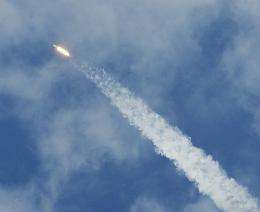The Space X Falcon 9 rocket heads for space in June 2010 in Florida, on its first test flight. The US company has received the go-ahead to launch its first space capsule into orbit Wednesday, in a key test for the future of commercial space flight as NASA looks to end its shuttle program.
A US company has received the go-ahead to launch its first space capsule into orbit Wednesday, in a key test for the future of commercial space flight as NASA looks to end its shuttle program.
"It's Go for launch," NASA said in a tweet late Tuesday. "The launch of the SpaceX Falcon 9 is on for Wednesday. The window opens at 9 am (1400 GMT)."
The launch by the US company SpaceX was postponed Monday after engineers found a three-inch (eight-centimeter) crack in the engine nozzle of the Falcon 9 rocket that was to carry the Dragon space capsule, NASA said.
The Dragon spacecraft aims to blast off from Cape Canaveral in Florida, hurtle into orbit and then splash into the Pacific Ocean about four to five hours later, said SpaceX.
The operation hopes to showcase the capsule's ability to launch and separate from the Falcon 9 rocket, orbit Earth, transmit signals and receive commands, and then re-enter the Earth's atmosphere for an ocean recovery.
If the Dragon launch is successful, the next step is for a fly-by of the ISS as part of a five-day mission in which the Dragon will approach the orbiting station within six miles (10 kilometers).
Later, an actual cargo and crew mission to the ISS is planned. Both are scheduled to take place in 2011.
As tall as an 18-story building, the Falcon 9 rocket that will carry the Dragon was successfully test launched in June.
The US space agency NASA signed a 1.6-billion-dollar contract with SpaceX in December 2008 under the Commercial Orbital Transportation Services (COTS) program to provide 12 spacecraft with cargo capacity of at least 20 tonnes to resupply the International Space Station (ISS) through 2016.
NASA has also signed a contract of 1.9 billion dollars with Orbital Space Corporation for eight launches of its Taurus II rocket starting in 2011.
President Barack Obama hopes the private sector will help fill the gap that will open when the space shuttle fleet is retired next year, and before a new generation of spacecraft is developed.
The three US shuttles -- Discovery, Atlantis and Endeavour -- will become museum pieces after a final shuttle mission to the space station in 2011.
Obama has proposed spending six billion dollars over five years to help the private sector develop reliable and affordable launchers to transport cargo and US astronauts to the International Space Station.
During the transition period, the United States will depend on Russian Soyuz rockets for access to the ISS.
(c) 2010 AFP





















